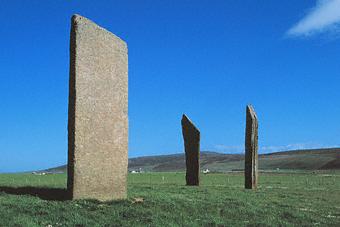| Region : | Orkney |
|
|
| Island : | Mainland | ||
| Town or village : | Stenness | ||
| Grid Reference : | HY 306 125 | ||
| Period : | Early 3rd millennium BC | ||
STONE CIRCLE, HENGE
 |
|
They stand inside a henge, some 30m in diameter, within a rock-cut ditch and an external bank. Some 130,000 tons of hard rock were quarried from the ditch. The henge's only entrance was at the north side, towards Barnhouse settlement.
In the centre, excavations in 1973 revealed a rectangular setting of stones (similar to a domestic hearth like those at the Neolithic village of Skara Brae) with some cremated bones inside.
The site is not far from Ring of Brodgar circle and from two tall standing stones, Watch Stone and Barnhouse Stone. Nearby, a third monolith, the holed Stone of Odin, was destroyed in 1814 by a tenant farmer (not an Orcadian). The man tried to demolish the Stones of Stenness too, but was stopped by the fierce opposition of the local people, who tried to burn down his house.
A rich folklore surrounds the stones. As Raymond Lamont-Brown wrote in his Scottish Folklore: "People suffering from a multitude of diseases would walk (or be carried) three times round the Stones of Stenness for a certain cure, the superstitious assured".
According to another old tradition, each New Year's Day the local people met at Stenness church and feasted for several days. Then, those of the young folk who were planning to marry went to the Stones of Stenness (also known as Temple of the Moon). Here the girl knelt in front of the boy and prayed the god Odin (Wodden) that he would enable her "to fulfil all the promises and obligations she had". Then the lovers went to the Ring of Brodgar (Temple of the Sun) where the man repeated the woman's prayer. At last they clasped hands through the hole in the Stone of Odin (Temple of the Stars) and swore to be constant and faithful to each other.
Aubrey Burl in his Circles of Stone. The Prehistoric Rings of Britain and Ireland records this story: "The Odin oath was so binding that a Stromness woman who had sworn it with her pirate sweetheart (John Gow, executed in 1725) travelled to London, after he was hanged in chains off Greenwich, and retracted it as she held his dead hand".
In care of Historic Scotland